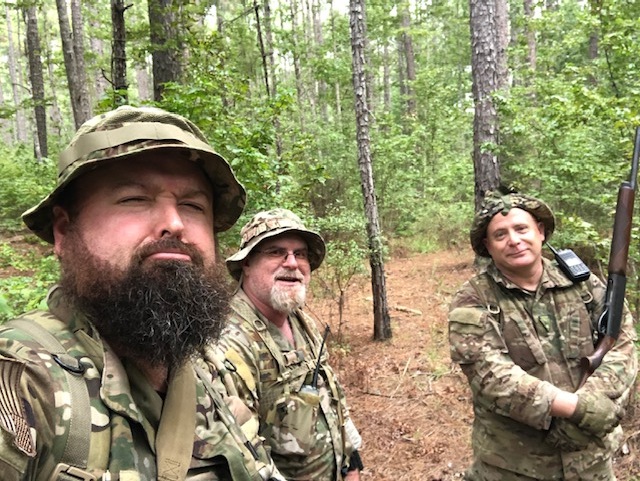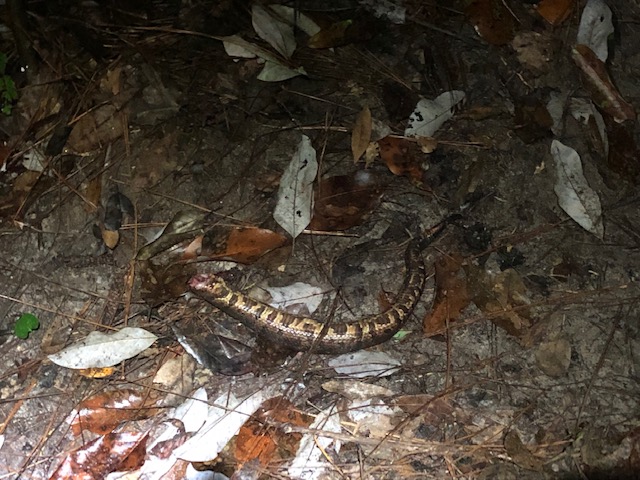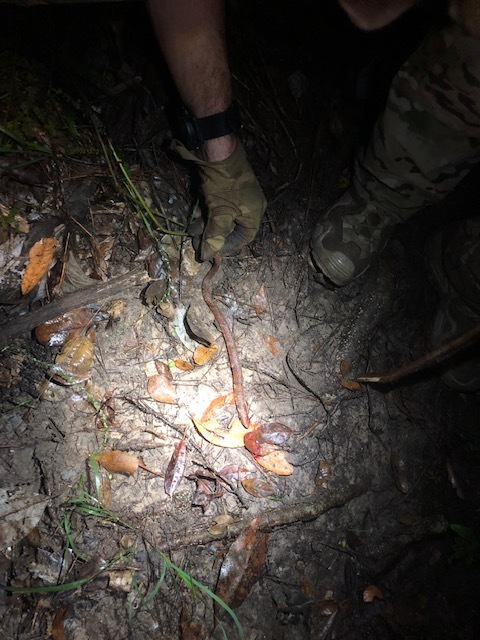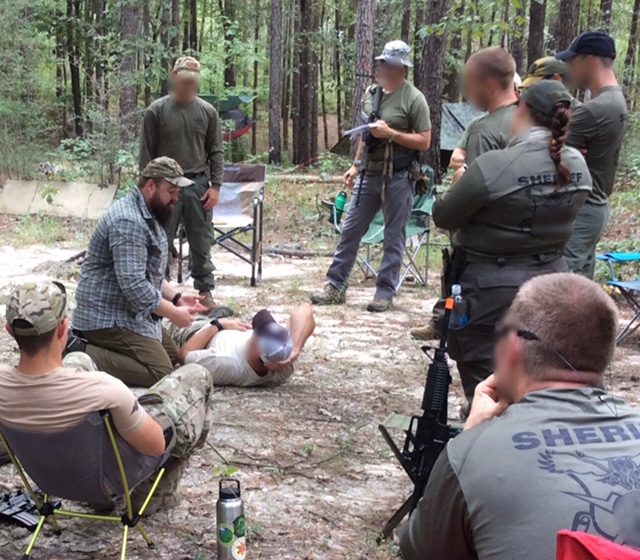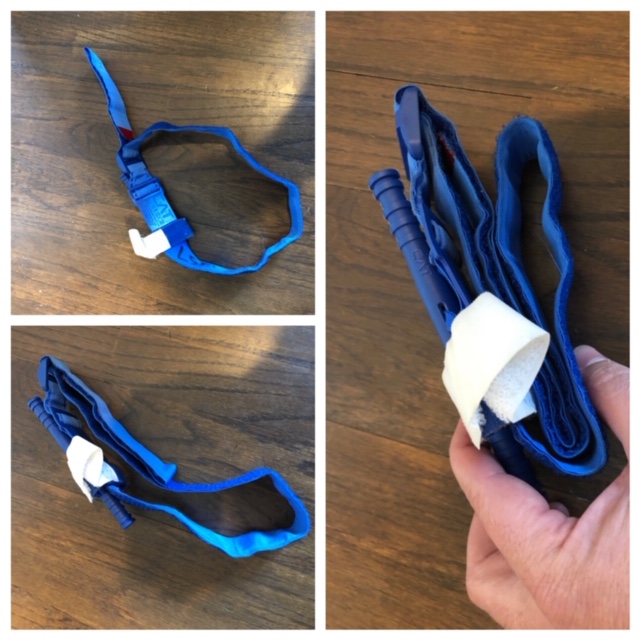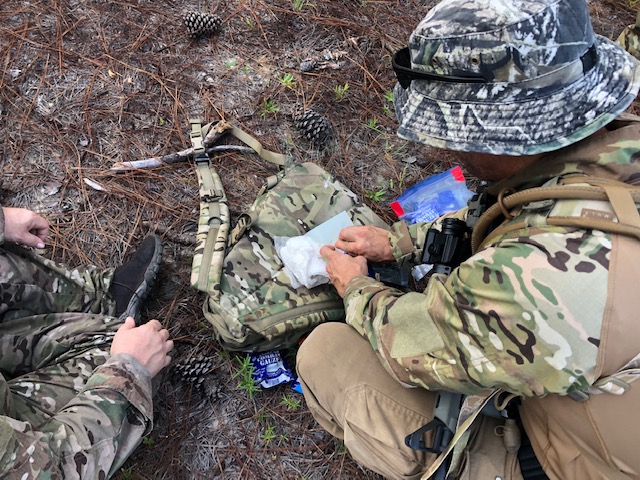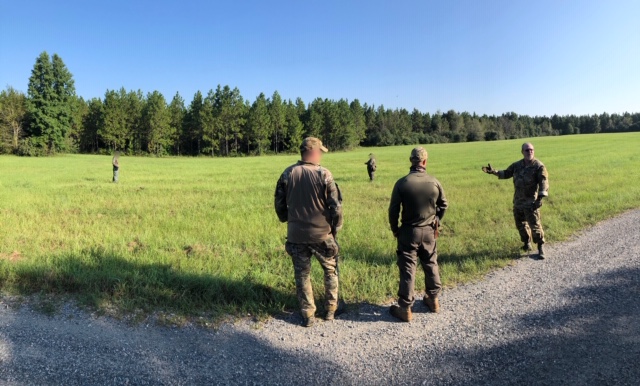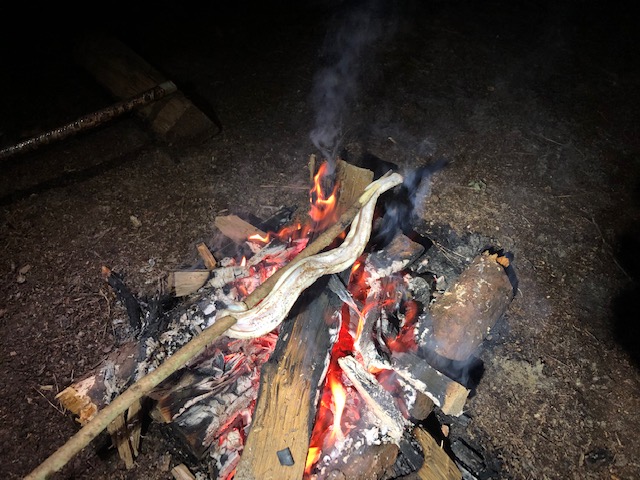Lessons Learned from "Rural Pursuit & Tactical Medicine"
23AUG2019
We just wrapped up a five day “Rural Pursuit and Tactical Medicine” course in collaboration with Tyr Group, LLC (https://tyrgroupllc.com/rural-pursuit-and-tactical-medicine-course-5-day). I wanted to share some lessons learned and a brief recap of this course with y’all. Some of these lessons learned are medically related and some are for general purpose, I’ll let you the reader apply them as needed.
The “Rural Pursuit and Tactical Medicine” course is a five-day immersion course originally developed to provide law enforcement officers the skills needed to track down dangerous subject(s) through a rural environment. This particular course was restricted to active law enforcement only (with the exception of one student who is a member of his local Search & Rescue team that deploys with their law enforcement officials). Students learn basic visual tracking, tactical tracking techniques, small unit tactics, mission planning, and tactical medicine. The tactical medical portion includes field medicine, trauma management, medical mission planning and sustainment, evacuation contingencies, wound management, environmental emergencies, and more. This is about the sixth or seventh course that Tyr Group and Lone Star Medics has taught together. John Hurth is a former US Army Special Forces solider who runs Tyr Group and is the lead instructor for this course. Hurth provides professional tactical instruction and consulting throughout the United States to civilians, law enforcement, and military personnel. You can read about his background on the Tyr Group website, but for now, let me just say that John is one of the few out there teaching combat tracking with real world experience combined with a strong passion for teaching this underappreciated skill set. Not only does Hurth teach combat tracking, but he offers land navigation courses for beginners to expert levels. Some other courses he offers on occasion are counter tracking, surveillance and reconnaissance, and small unit tactics (SUT). Tyr Group’s SUT course teaches you how to move from one point to another in groups of two or more. Which even if you’re not someone who makes a living running through the woods chasing bad guys and girls; you’d be surprised to see how the principles of the SUT course translate to a family trying to move on foot from an apartment lobby to their vehicle located on the other side of a large parking lot immediately following a jewelry heist that turned into a disgruntled renter of said apartment complex. (Yes, I’m referring to my family’s COSTCO experience last year.) The point is that you learn more than you think from John’s classes. Do yourself a solid and take advantage of the courses that Tyr Group offers.
Now, back to what I was saying about Rural Pursuit…
Lesson Learned #1
Hydration ain’t enough, your clothing selection can make or break you in hot, humid environments.
The environment alone can kill you; plan accordingly. Some parts of the beautiful state of Louisiana in August reminds me of my trips to the jungles in Central America. The jungle wants to kill you; remember that fact. Sure it was hot and extremely humid down in the deep dark scary woods of the Kistachie National Forest. But it also happens to be home to one of the most beautiful forests and swamplands in the world; in my humble opinion. The lesson learned is that you must be prepared to live and function in that type of heat. Oh, and there was never any wind; at all. The key to working in such an environment is to wear loose fitting clothing and wear synthetic clothing. Cotton is rotten! The problem with most combat uniforms today is that they are not designed to be worn in humid and tropical environments. Everything I owned got wet and stayed wet; either from sweat or rain. We lucked out this trip and only had one quick torrential downpour that gave us all a good soaking. So now that your uniform is soaked in sweat or rain, how quickly can it dry out? That sweet looking graphic T-shirt rocking your favorite logo on it will become a wet sponge and will stay wet for several hours, maybe even days. Which means you’re basically trapping any and all your body heat under that wet cotton T-shirt. If the temperature drops even just 10-15° while you still have that wet cotton clothing on; you could very easily become hypothermic (fancy medical word that means “you’re cold and not in a good way.”) I was rocking the RECON pants (https://vertx.com/vertx-recon-pants) and RECON Garrison shirt (https://vertx.com/recon-pants-and-shirts) from Vertx while out in the bush. This uniform has held up pretty well over the past few years of taking Tyr Group’s courses and a few adventures in the woods on my own. The organized pockets on both provide easy and quick access to items without having to take the time to stop and dig through your pack for that one “thing.” Long sleeves and pants are a must when moving fast and light in a wooded environment. It won’t take long for you to appreciate the protection they offer from thorny bushes, bugs crawling on you while laying low in your hide site, and keeping the sun from beating down on you. To minimize chafing, I wore moisture wicking boxer briefs and undershirts. Thin, lightweight wool hiking socks from SmartWool and Darn Tough are an absolute must for me; in any environment. I made the mistake of bringing two pairs of boots that both have a waterproof liner (read, Gore-Tex). Which means the inside of my boot turned into a swamp by the second hour of each day. So either wear boots that don’t have a waterproof liner or carry spare, dry socks with you while you’re out and about in the woods. Thankfully I only developed one hot spot on my foot and was able to prevent full on blisters with a little bit of old school moleskin. The good thing about wearing my heavy duty leather hiking boots was that it offered some protection against vines with large thorns that were constantly grabbing my ankles, prevented twisted ankles while humping about 20lbs worth of gear, and snakes. More on snakes in a bit.
Lesson Learned #2
Learn from your students.
We had a pretty diverse group of students in this class. Students hailed from all over the country to represent the FBI, Border Patrol, Sheriff Departments, US Air Force, and Search and Rescue. Some had previous medical training and some had none at all; so it made for a decent challenge as an instructor. These men and women kept me on my toes the entire five days of class. A Special Agent with the FBI showed me how he prepares his CAT which limits the amount of engaged hook and loop material during storage. This minimizes application time and helps prevent the hook and loop from catching on itself during one-handed self-application. It does make the loop a bit smaller, but we’re talking about a couple inches in the grand scheme of things. Still, it was very cool of the Special Agent to teach me something new.
Snakes can be dangerous, but taste like smoked chicken. We had a few US Air Force SERE instructors as students and they truly are legit Bushmen. They are incredibly passionate about the outdoors, learning new skill sets, and sharing knowledge. So one night after class they invited me to join them to go exploring down in the creek bottoms near camp. It didn’t take long before we came across a couple of pit vipers, water moccasins to be more precise. We dispatched them humanely and used the opportunity to learn about these magnificent animals. I’ll admit, there are only three things in this world I am absolutely terrified of… polar bears, cockroaches, and snakes. And not in that order either. These guys showed me how to skin and clean the snakes. They taught me that even poisonous snakes are edible when prepared appropriately. You see, you have to cut about two to three head lengths back to ensure that you have removed the venom glands. We measured three and a half just to make sure. One big take away for myself was learning that most of a snake’s body is cartilage and the only part that has any real meat is the back strap. These guys know a lot about snakes and provided plenty of new information about them I had not known about before. Being the bushmen they are, they insisted that the learning experience continue by having me not only learn how to cook a snake over an open fire, but then eat the cooked meat. Turns out, water moccasin tastes pretty darn good… with a pinch of garlic powder and a dash of salt and pepper. However, I wouldn’t recommend it as a routine dining experience. We are talking about a rather dangerous species of animal here. I’ll stick to Texas cow, thank you very much.
Lesson Learned #3
Forced Hydration vs. Self-Regulation
Y’all know how I’m always preachin’ about being properly hydrated and to always drink plenty of water. I typically treat everyone like a brand new E-1 Private, and push forced hydration on them just so they’ll actually drink water. However, over the past few years John Hurth and I have been doing some self-studying on the matter. We’ve come to the unscientific conclusion that you might not need to be chugging down as much water as you think. I knew that the Louisiana heat and humidity in August was going to be brutal. So about three months earlier I started spending more and more time outside in the Texas heat to start acclimatizing my body. Working indoors with the AC blowing full blast all summer would have set me up for failure. I started doing basic yard work wearing the RECON pants with a T-shirt; and eventually worked my way up to being in full battle kit (minus the rifle) while doing “honey-do-lists” in the backyard. I would take the dog to the dog park mid-morning before it got too hot for her. Then we’d go for a walk around the neighborhood a few hours after the sun had gone down. I’d wear lightweight pants and long sleeve shirts to condition my body for the heat. Fast forward to day two of class and we’re hitting the track line in the deep woods with oppressive heat. Understand that we were constantly drinking sipping on water. No one could be found at any time or anywhere without a canteen of some sorts in their hands and sipping on water. What we were not doing was guzzling down gallons of water every hour in some sort of hopeless effort to try and catch up on being hydrated. I was consuming between two and three liters of water during while out on the track line. That means from the time we left camp and started moving through the thick brush I was listening to my body. During the tracking portion of class, myself and a few students take off into the woods and “lay sign” for the rest of the class to “track.” These track lines would range from 200-500 meters. Once we made the pre-determined distance for that track line, we’d set up to ambush the tracking team. While waiting on the tracking students to find us, I’d sip on some water. By the end of the day, I wasn’t gassed or tired or even dehydrated. I was urinating every hour or two, never stopped sweating, and never felt overheated. I would eat small bites every so often throughout the day, granola bars, a few energy bars from a local backpacking store back home, peanut butter and crackers, etc. At supper, most of us head in to Pitkin and grab a burger or Bayou Bite at Strother’s country store. Which after a long, hot, humid, brain-draining day of training; cold sweet tea and sitting in a real chair with air conditioning provides a welcomed quick rest. By acclimatizing my body months in advance, wearing the appropriate clothing/uniform, and consuming enough food and water; I really didn’t have any issues regarding dehydration or heat related injuries/illnesses.
Lesson Learned #4
Tactics are like… rectums; everyone has one.
With such a diverse group of students with various SOP’s specific to their home agencies and training backgrounds; sometimes it looked like a complete cluster when the students “came under fire” from the OPFOR (for a lack of better words and to keep this short). I’m not knocking them, just saying that learning had taken place on multiple levels. Terrain is everything, however it was interesting to watch those with only law enforcement backgrounds group up very close to each other and then move forward towards the threat while basically out in the open; once contact was made with OPFOR. Those with a military background would stay spread apart and would move from cover to cover towards the threat. Small unit tactics (SUT) are part of this course and Hurth was able to teach basic tracking formations and some forward bounds; but there is a reason Tyr Group offers a multi-day SUT course all on its own. Your tactics need to change with the terrain. What may be great for clearing through a house or building, may not be such a great idea when out in a rural environment. There are some similarities, but you have to stay flexible. Understand how and when to implement which formation or tactic in certain environments. By the end of class the students were able to take home some drills to practice with their entire teams. They also learned that communication needs to be clear and precise; both verbal and hand/arm signals. But comms is an entire different thing for another time. We ALL could use some more training on communicating with others.
Lesson Learned #5
Keep control of your medical gear during patient care.
During a wound packing skills station I noticed a handful of students lose control of their medical gear or even worse lose control of their wound packing material. The devil is in the details, y’all. For whatever reason there are medical instructors out there teaching students to put their packet of hemostatic agent down the front of their shirt and pull the gauze out from the top of their shirt. That may work in a controlled setting like an air conditioned classroom, but when you’re shirt is soaked in sweat or rainwater that might not be a great idea. Hemostatic agents react (good or bad) immediately with liquids; to include water, sweat, blood, urine, bile, vomit, hydraulic fluid, and so on. My point is that why would you expose your very limited amount of available resource (that one packet of Combat Gauze in your IFAK) to such a risk of failure? We had one student throw the packet over their shoulder and start dragging the gauze across their back, over their shoulder, and then pack it in the wound. Did I mention all of us were soaked in sweaty uniforms from being out in a swamp for three days? So you can imagine how “clean” the gauze was when they tried packing it into the Wound Cube wound trainer (https://www.phokusresearch.com/products/wound-cube-wound-simulator). As students were packing the wound, some would pull out two or three feet of gauze from the packet, place the packet on the ground a few feet away from the wound. This allowed pine needles, dirt, debris and even one very nervous grasshopper to get all tangled up in the gauze as it was being packed. Here is a marvel idea… how about we just hold on to the packet of hemostatic agent with one hand and only remove the gauze as we go along packing the wound with our hands right there next to the wound! The packaging will help protect the gauze while you pack the wound. Plus it allows you to maintain constant positive control in case someone or something accidently yanks on that packet and jerks all that fine work you did out of the wound cavity. Which means you now have to start all over and with less resources at your disposal. In other training scenarios I’ve seen students run up and try to “help” and end up tripping over an aid bag, scattering medical gear everywhere. Keep control of your medical gear during patient care.
Overall, this was not an easy class for me to teach due to the various medical backgrounds and skill levels of everyone. I enjoyed it and always welcome a challenge like this. Perhaps my favorite part of this entire course was learning… from my students.
https://tyrgroupllc.com/
https://www.phokusresearch.com/
https://vertx.com/
http://1110gear.com/
Drink Water,
-Caleb

